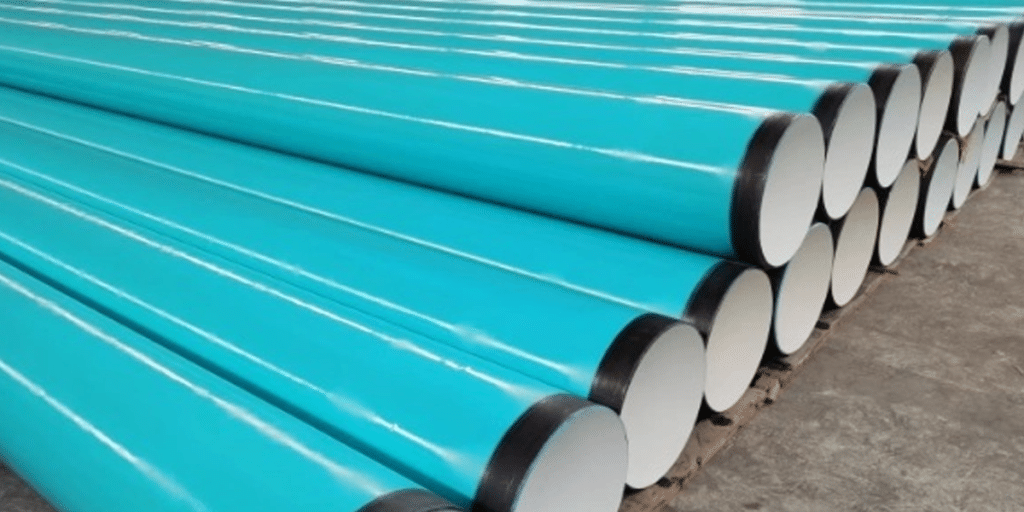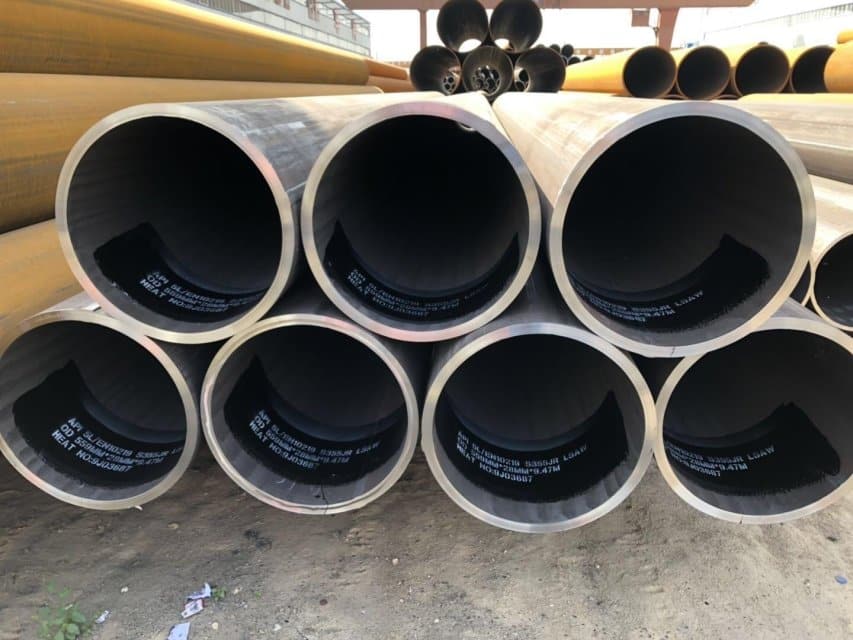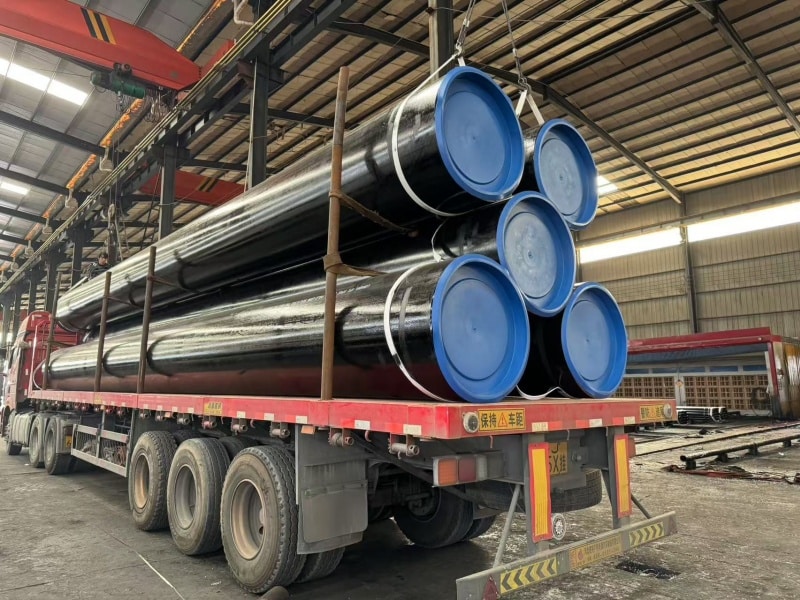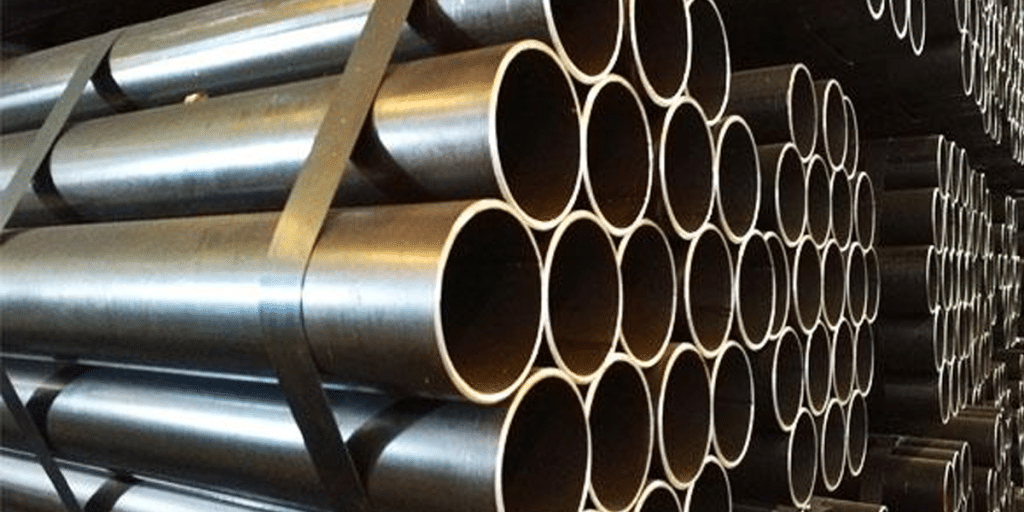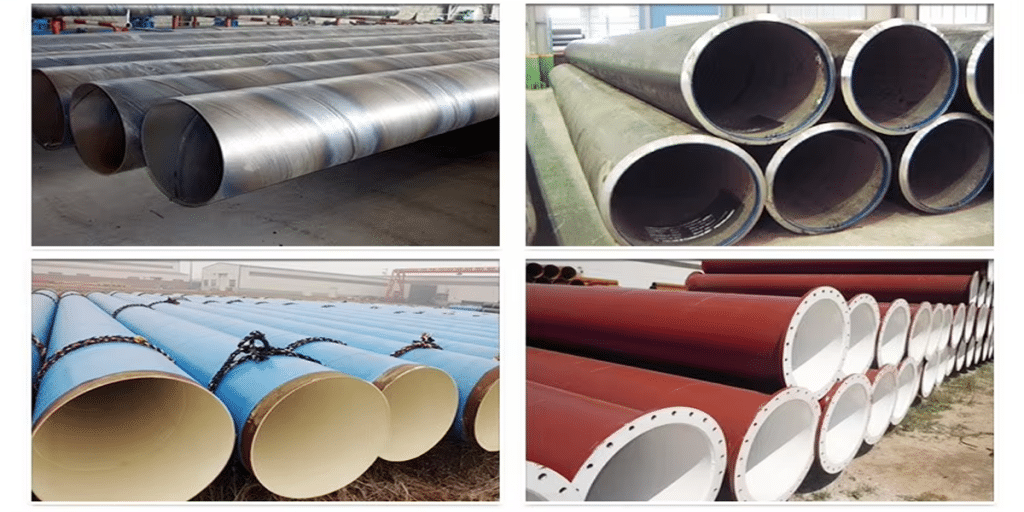In the wave of continuous global industrial upgrades, steel pipe standards and selection have become a focal point for many companies. Whether in oil and gas pipeline projects or high-temperature, high-pressure boiler applications, how to choose the right steel pipe standard directly affects project safety, costs, and the convenience of later maintenance. Faced with a wide variety of specifications on the market—such as ASTM A53, ASTM A106, and API 5L—many engineering professionals are seeking a practical steel pipe selection guide to help them understand the performance differences and application areas of each standard.
In recent years, with the rapid development of the energy, chemical, and infrastructure sectors, the application of ASTM A106 steel pipes has been growing year by year, while the basis for selecting API 5L pipes is also receiving increasing attention. At the same time, making a scientifically sound choice among numerous standards and complex specifications has become a crucial issue at the initial stage of every engineering project. This article will focus on the core question of how to choose steel pipe standards, and will offer you a comprehensive and practical reference—from standard comparisons and application scenarios to steel pipe standard selection techniques—to help every engineer accurately realize the value of each steel pipe.

Overview of Common Steel Pipe Standards
Steel pipes are widely used across the globe in fields such as oil and gas transportation, chemical equipment, high-temperature and high-pressure piping, and structural engineering. Due to the diverse operating environments and conditions, how to choose the right steel pipe standard becomes a critical decision at the start of every engineering project. This article provides a systematic review and comparison of several widely used standards in the industry, helping you build a practical steel pipe selection guide.
1. ASTM A53
ASTM A53 is a carbon steel pipe standard developed by the American Society for Testing and Materials (ASTM), mainly intended for mechanical and pressure applications as well as general-purpose piping.
Standard Features:
Types: Seamless and welded (black and galvanized)
Wide nominal size range
Suitable for medium to low pressure
Material: Carbon steel
Typical Applications:
Fire protection piping
HVAC and ventilation systems
General fluid transportation
Selection Tip:
If your project does not require stringent temperature or pressure conditions, ASTM A53 is an economical and readily available general-purpose standard.
2. ASTM A106
ASTM A106 is designed specifically for high-temperature service and is one of the most common seamless carbon steel pipe standards in the US.
Standard Features:
Type: Seamless only
Grades: A, B (most common), and C
Suitable for high-temperature and high-pressure service
ASTM A106 Steel Pipe Applications:
Power plant boilers
High-temperature petrochemical plants
Refineries and pressure vessels
Selection Tip:
For applications involving high-temperature fluid transport, ASTM A106 is often recommended in steel pipe selection guides for its excellent heat resistance and reliability.
3. API 5L
API 5L is a standard developed by the American Petroleum Institute (API), primarily for oil and gas pipeline transportation.
Standard Features:
Types: Seamless and welded
Technical grades: PSL1 and PSL2 (PSL2 is more stringent)
Strength grades range from B to X80
API 5L Steel Pipe Selection Basis:
Long-distance oil and gas transmission
High strength and corrosion resistance requirements
Buried pipelines
Selection Tip:
Type: Seamless
Materials: Alloy steel or carbon steel
Temperature capability: Can withstand temperatures above 580℃
Common grades: St35.8, 15Mo3, etc.
For cross-regional long-distance pipelines, API 5L offers a wide range of grades and excellent reliability, making it a preferred choice.
4. DIN 17175
DIN 17175 is a German standard specifically for high-temperature seamless steel pipes, especially suited for high-temperature and high-pressure environments such as boilers and heat exchangers.
Standard Features:
Typical Applications:
Power station boilers
High-temperature heat exchanger tubing
Industrial furnace piping
Selection Tip:
For European projects or those involving high-temperature equipment, DIN 17175 is widely used for its superior high-temperature performance and strict quality standards.
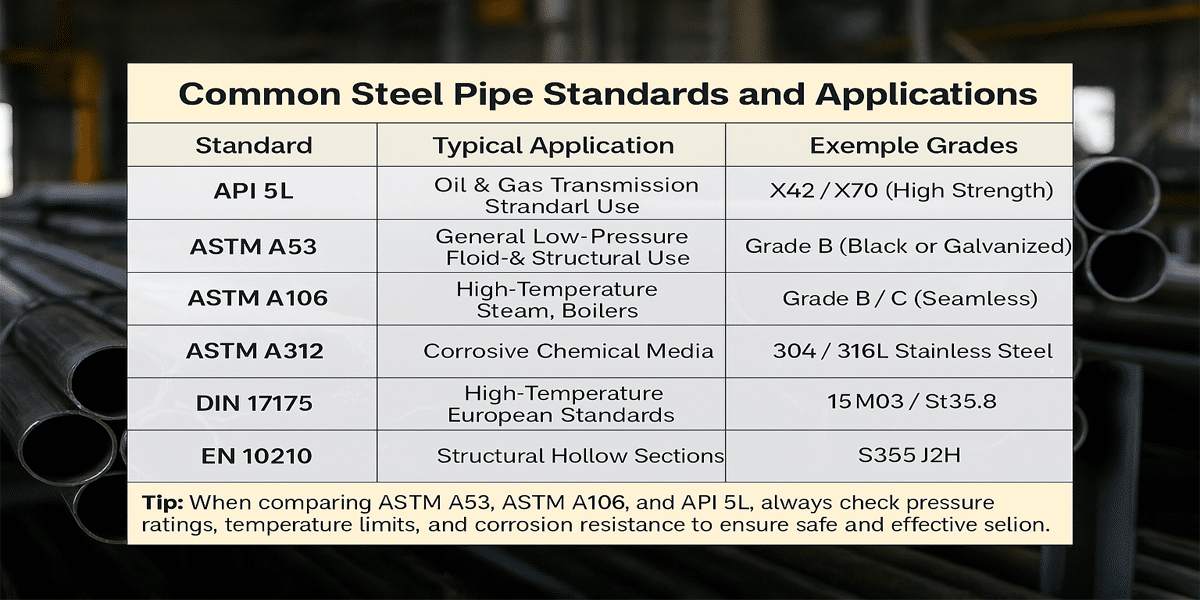
How to Select the Right Steel Pipe Standard Based on Project Requirements?
In engineering projects, choosing the appropriate steel pipe standard directly affects safety, compliance, and overall project cost.
1️⃣ Define Basic Project Requirements
Before selecting any standard, you must accurately define your project needs:
✅ Medium Type
Fluids: water, oil, gases (natural gas, steam)
Corrosive chemicals: acidic or alkaline solutions, seawater
Structural use: supports and load-bearing frameworks
For example, if you need to transport high-temperature steam, the application of ASTM A106 steel pipes is one of the most typical scenarios, widely used in power station boilers and high-temperature process lines.
✅ Operating Environment
Temperature: high (>400°C) or low (<-20°C)
Pressure level: high-pressure (e.g., transmission pipelines) or low-pressure systems
Corrosive environment: marine platforms, buried pipelines in acidic soils
Mechanical loads: vibration, impact, fatigue
✅ Regulations and Certifications
Industry standards: Oil & Gas (API), Chemicals (ASTM, ASME), Construction (EN, ISO)
Regional standards: Europe/US (ASTM, EN), China (GB/T)
🌟 Steel pipe standard selection tips: Always confirm mandatory regulatory standards first—meeting performance alone is not sufficient for approval.
2️⃣ Key Performance Indicators
Within the steel pipe selection guide, performance matching is at the core of decision-making:
✅ Mechanical Properties
Strength: High-pressure transmission requires high yield strength
For example, API 5L pipe selection basis: Grades like X52, X70, X80 are used in long-distance gas pipelines for high strength and excellent weldability.
Toughness: Low-temperature impact resistance
ASTM A333 Grade 6 is designed for -45°C service conditions.
✅ Corrosion Resistance
Acidic or salt spray environments: use stainless steel or special corrosion protection
ASTM A312 316L is suitable for chemical media
ASTM A53 can be galvanized for buried or outdoor pipelines
✅ Dimensions and Tolerances
Precision tubes (hydraulic or mechanical) require tight dimensional tolerances
EN 10305-1 is ideal for precision applications
🌟 Steel pipe standard selection tips: Always evaluate strength, toughness, and corrosion resistance together—never isolate one factor.
3️⃣ Common Standards and Applications
In practice, different standards are selected for different working conditions. The table below offers a comparison of ASTM A53, A106, and API 5L, among other common standards:
🌟 The application of ASTM A106 steel pipes is very common in power plant high-temperature piping, while API 5L is the internationally recognized preferred standard in oil and gas transmission.
4️⃣ Process and Cost Balance
Beyond technical standards, you must consider manufacturing methods and cost efficiency:
✅ Seamless Pipes (ASTM A106)
Advantages: excellent integrity, superior pressure and temperature resistance
Disadvantages: longer production time, higher cost
Recommended for high-temperature, high-pressure services.
✅ Welded Pipes (ASTM A53)
Advantages: cost-effective, fast production
Disadvantages: weld quality has a significant impact on performance
Suitable for medium- and low-pressure applications.
✅ Surface Treatments and Coatings
Galvanizing: ASTM A53 galvanized pipes are ideal for outdoor or buried installation
Fusion Bonded Epoxy (FBE) coating: commonly applied to API 5L buried pipelines
🌟 Steel pipe selection guide tip: If your project demands both high-pressure/high-temperature and corrosion resistance, consider ASTM A106 seamless alloy pipes or DIN 17175 materials.
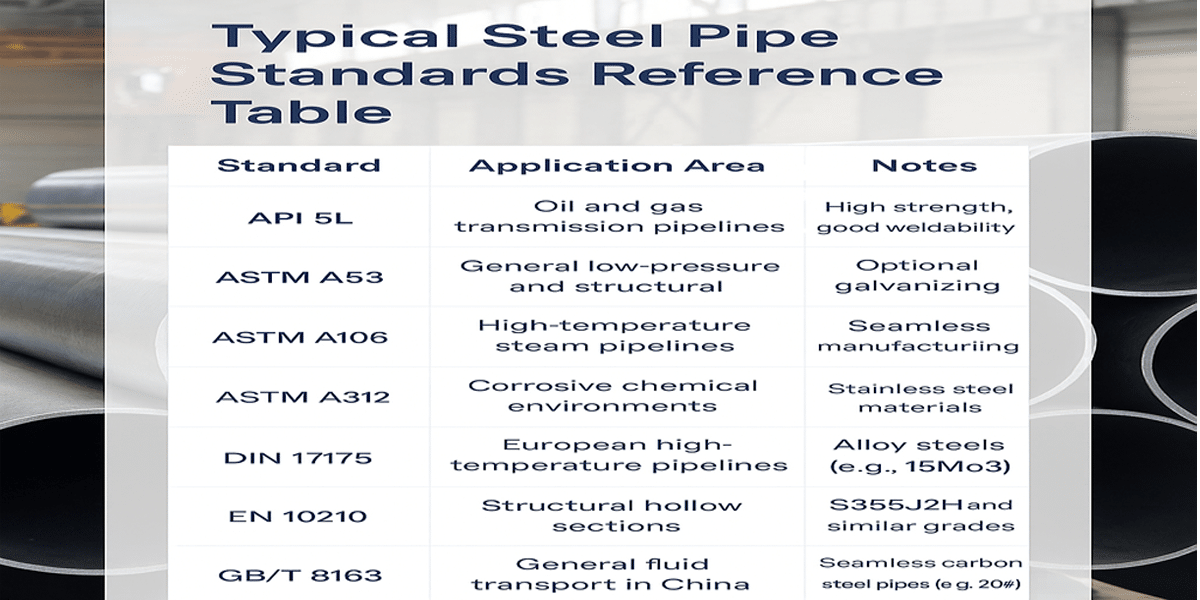
Detailed Basis for Selecting Steel Pipe Standards
In any engineering project, how to choose a steel pipe standard is a critical decision that directly affects safety, compliance, and project economics.
1️⃣ Project Working Conditions
This is the most fundamental starting point in any steel pipe selection guide, and includes:
✅ Type of Medium
Fluid media: water, oil, natural gas, steam
For example: when transporting natural gas, API 5L X70 offers high yield strength and good toughness. The API 5L pipe selection basis focuses on strength, weldability, and corrosion resistance.
Corrosive media: chemicals, acidic or alkaline solutions
In this case, ASTM A312 stainless steel standards are often preferred.
Structural applications: load-bearing supports
✅ Temperature and Pressure
High temperature (>400°C): choose ASTM A106 seamless pipes or DIN 17175 high-temperature pipes
Low temperature (<-20°C): consider ASTM A333 low-temperature pipes
High pressure: API 5L or higher grades of ASTM A106 are recommended
✅ Installation and Service Environment
Marine environments: require additional anti-corrosion protection (e.g., 3PE, FBE coating)
Underground installations: need soil corrosion resistance
Outdoor exposure: ASTM A53 galvanized pipes can be used
2️⃣ Regulatory and Certification Requirements
In steel pipe standard selection tips, compliance is absolutely essential:
✅ International Standards
API: oil and gas sector, such as API 5L, API 5CT
ASTM: widely applied in US and international engineering
EN/DIN: required for EU projects
✅ National/Regional Standards
Chinese GB/T standards
European EN series standards
✅ Client or Industry Specifications
Oil & Gas, chemical, and power industries often require specific documentation and certificates
🌟 Tip:
When doing an ASTM A53 A106 API 5L comparison, don’t only look at performance—always confirm if the standard is legally recognized in the project region.
3️⃣ Performance and Manufacturing Requirements
In the steel pipe selection guide, performance matching is the core consideration:
✅ Mechanical Properties
Yield strength, tensile strength: define pressure containment capability
Impact toughness: critical for low-temperature or vibration-prone applications
Ductility and weldability: affect manufacturing and installation
✅ Corrosion Resistance
Highly corrosive environments: prioritize stainless or alloy steels
For example, the application of ASTM A312 316L pipes is mainly in chemical and marine projects.
Moderate corrosion: ASTM A53 galvanized pipes are commonly used
✅ Dimensions and Tolerances
Precision machining or hydraulic systems: EN 10305 series pipes
General transport pipelines: API and ASTM standards with standard tolerances
4️⃣ Process and Cost Balance
Different standards involve different manufacturing methods, and costs can vary significantly:
✅ Seamless Steel Pipes
Advantages: high reliability, excellent high-pressure and high-temperature performance
Typical standards: ASTM A106, DIN 17175
Applications: power plants, high-temperature service
✅ Welded Steel Pipes
Advantages: lower cost, higher production efficiency
Typical standard: ASTM A53
Applications: low-pressure fluid transport, structural purposes
✅ Special Surface Treatments
Anti-corrosion coatings: 3PE, FBE
Hot-dip galvanizing: improves weather resistance
5️⃣ Typical Standards Reference Table
Here is a concise comparison table for initial selection:
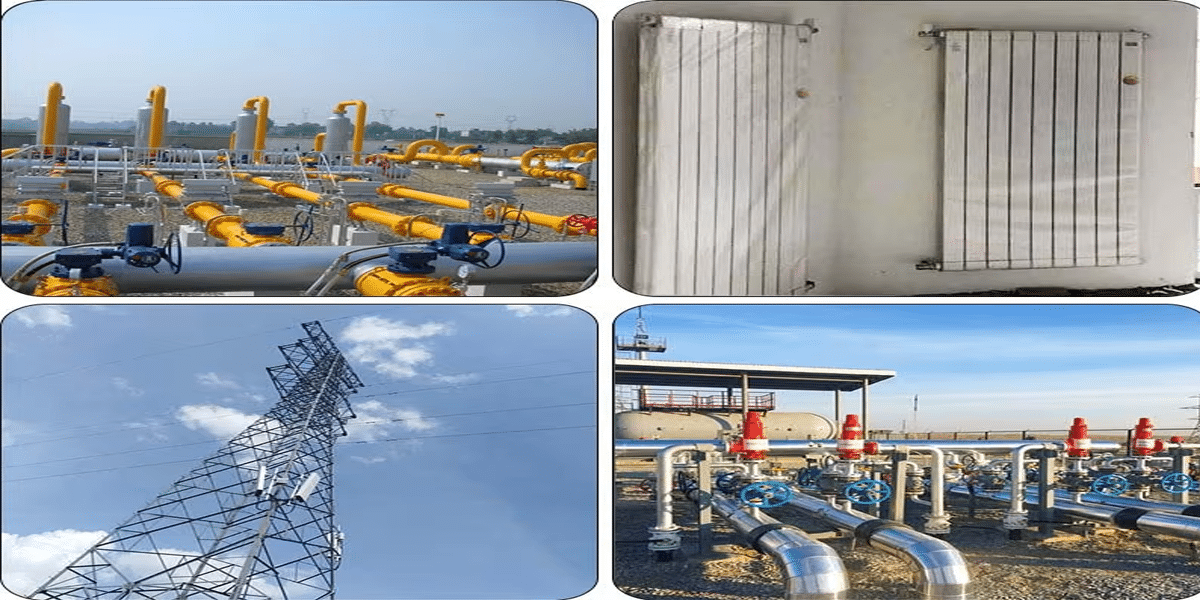
Application Scenario Analysis of Common Steel Pipe Standards
Understanding the typical scenarios each standard applies to is the most critical part of how to choose a steel pipe standard. Here is a detailed analysis:
1️⃣ API 5L — Oil and Gas Transmission Pipelines
✅ Application Areas:
Long-distance oil and gas pipelines
Urban gas distribution networks
Offshore subsea pipelines
✅ Key Features:
Multiple steel grades (X42, X52, X65, X70, X80)
High yield strength and excellent weldability
PSL1 and PSL2 product specifications (PSL2 has stricter quality requirements)
✅ Typical Examples:
West–East Gas Pipeline Project
Offshore gas platform pipelines
👉 API 5L pipe selection basis:
Transmission pressure
Corrosion resistance in buried or marine environments
Structural safety in long-distance transport
2️⃣ ASTM A53 — General Low-Pressure and Structural Use
✅ Application Areas:
Fire protection pipelines
Water supply and drainage
General structural supports
✅ Key Features:
Available in seamless and welded types
Optional hot-dip galvanizing for corrosion resistance
Excellent cost performance for non-high-pressure use
✅ Typical Examples:
Fire sprinkler systems in commercial buildings
Municipal water distribution networks
👉 In the ASTM A53 A106 API 5L comparison, ASTM A53 is more oriented toward low-pressure and construction applications, while API 5L targets high-pressure transmission.
3️⃣ ASTM A106 — Seamless High-Temperature and High-Pressure Pipe
✅ Application Areas:
Power plant boiler pipelines
High-temperature steam transportation
Petrochemical process piping
✅ Key Features:
Suitable for service temperatures from -29°C to +538°C
Seamless manufacturing ensures high reliability
Common grades: Grade B and Grade C
✅ Typical Examples:
Main high-temperature steam pipelines in thermal power stations
Refinery process piping
👉 ASTM A106 pipe applications focus on high-temperature and high-pressure service.
4️⃣ DIN 17175 — High-Temperature Alloy Steel Pipe
✅ Application Areas:
Boiler pipelines in European markets
High-temperature chemical process equipment
Heat exchangers
✅ Key Features:
Suitable for high-temperature loads
Typical materials: 15Mo3, 13CrMo44
Good creep resistance
✅ Typical Examples:
Main steam pipelines in European thermal power plants
5️⃣ ASTM A312 — Stainless Steel Corrosion-Resistant Pipe
✅ Application Areas:
Chemical industry and food-grade fluid transport
Marine engineering pipelines
Pharmaceutical equipment piping
✅ Key Features:
Available in multiple materials (304, 316L, 321)
Superior corrosion resistance
Excellent weldability and polishability
✅ Typical Examples:
Saltwater delivery systems
Sanitary piping in food processing plants
Through an in-depth analysis of common steel pipe standards and their application scenarios, it is clear that proper selection is not only about compliance but also directly impacts the safety, durability, and cost-effectiveness of your project. Whether you are dealing with high-temperature, high-pressure conditions or environments requiring exceptional corrosion resistance, you must comprehensively compare the technical specifications and suitability of different standards. We hope this steel pipe selection guide provides you with practical insights to support informed decision-making in your project planning. If you have further questions about how to choose steel pipe standards, ASTM A53 A106 API 5L comparison, or other steel pipe standard selection tips, please feel free to contact us. Together, we will find the solution that best fits your project needs!

